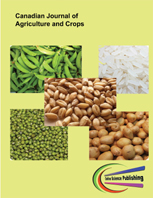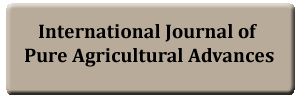Variation in Milk Yield and Composition of West African Dwarf Does fed Cassava Peel based Diets Supplemented with African Yambean Concentrate in the Humid Zone of Nigeria
DOI:
https://doi.org/10.20448/803.4.1.1.10Keywords:
Composition, Cassava peel, Milk, Dairy goat, Yambean.Abstract
This study investigated the variation in milk yield and composition of West African Dwarf goats (does) fed cassava peel meal based- diets supplemented with varying levels of African yambean seed meal (AYBM). Four experimental diets designated as T1, T2, T3 and T4 with 0, 10, 20 and 30% levels of AYBM respectively were used in the feeding trial. A total of twelve does with average weight of 19.6±1.12kg were used in this study. The does which were in their second to third parities were randomly divided into 4 groups of 3 animals each. Each group was assigned to one of the experimental diets in a Completely Randomized Design (CRD) experiment. Each animal was housed separately in cement floored pens measuring 1.85m x 1.70m (3.15m2). Dry hay material was used as bedding. During the first 4 months of pregnancy, the does were zero-grazed with forage consisting mainly Penisetum purpureum, Pueraria phaseoloides and Centrosema pubesens. Daily dry matter provision for each animal was based on 3% body weight. In the last trimester of pregnancy, each in-doe received 0.5kg of a concentrate diet in the morning (0800hr) and 1.0kg Penisetum purpureum in the afternoon (1400hr). This nutritional regime continued through parturition and into the 10th week of lactation for each doe. Water was provided ad libitum throughout the study duration. After the 10th day post –partum, the respective does were hand – milked daily and associated milk parameters such as yield and composition (lactose, total solids, butter fat, crude protein, solid–non fats, ash and gross energy) determined accordingly. Correlation coefficients were computed and simple linear regression was used in ascertaining the relationship between the parameters/constituents in goat milk. Results showed significant (P<0.05) differences in weekly variations in milk yield (1.88 – 3.32 kg) and constituents (4.05 – 4.52% lactose, 0.87 – 1.06% ash and 3.89 – 3.53 MJ/kg energy). The Milk yield generally rose with time post- partum and reached peak yield (3.32kg) in week 3 before declining. There were however significant differences (P<0.05) between the peak yield of week 4 and yield obtained in the 7th (2.43kg), 8th (2.43kg), 9th (2.55kg) and 10th (1.88kg) week, respectively. Milk yield was negatively and significantly correlated with total solids (r = -0.59; P<0.05), crude protein (r = 0.71; P<0.01), solid –non fats (r = - 0.87; P<0.01) and milk energy (r = -0.79; P<0.01), but poorly and positively correlated with butter fat (r ~ 0.01; P>0.05), and lactose (r = 0.42; P<0.05). Significantly high (P<0.05) positive correlation existed between BF and TS (r = – 0.55) and CP (r - 0.54), energy and TS (r = - 0.57) while a significantly high (P<0.01) but negative correlation existed between CP and SNF (r = -0.75). Lactose was negatively, poorly and non-significantly correlated with TS (P>0.05; r = -0.22) in this study. The study concludes that dairy goats fed 10% AYBM maintained milk high yield and optimum composition.


